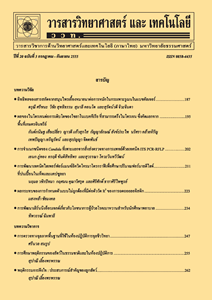Adaptation of Birds to Nest on Buildings and Pylons
Main Article Content
Abstract
When the natural suitable nesting sites are rare, some birds can adapt to habit on the buildings or the pylons. In the coastal cities, there are many gull species that their nests have raised on the roof of the buildings. Many studies suggest that most nesting birds on the buildings have high reproductive success because of safety life from predators and the bad weather. Nevertheless, bird nesting on the buildings give both advantages and disadvantages to human. The nesting birds on the pylons are often collision or electrocution. However, providing some tools or nest boxes with the pylons could make the birds build their nests easier. Currently, there is a growing awareness of preserving rare bird species with its nest on the buildings and the pylons.
Article Details
References
Rao, S. and Koli, V.K., 2017, Edge effect of busy high traffic roads on the nest site selection of birds inside the city area: Guild response, Transp. Res. D 51: 94-101.
Soldatini, C., Albores-Barajas, Y.V., Mainardi, D. and Monaghan, P., 2008, Roof nesting by gulls for better or worse?, Ital. J. Zool. 75: 295-303.
Perlut, N.G., Bonter, D.N., Ellis, J.C. and Friar, M.S., 2016, Roof-top nesting in a declining population of herring gulls (Larus argentatus) in Portland, Maine, USA. Waterbirds 39: 68-73.
Monaghan, P. and Coulson, J.C., 1977, Status of large gulls nesting on building, Bird Stud. 24: 89-104.
Raven, S.J. and Coulson, J.C., 1997, The distribution and abundance of Larus gulls nesting on building in Britain and Ireland, Bird Stud. 44: 13-34.
Rock, P. and Vaughan, I.P., 2013, Long-term estimates of adult survival rates of urban Herring gulls Larus argentatus and Lesser black-backed gulls Larus fuscus, Ring. Migrat. 28: 21-29.
Vermeer, K., Power, D. and Smith, G.E.J., 1988, Habitat selection and nesting biology of roof-nesting Glaucous-winged gulls, Colon Waterbirds 11: 189-201.
Dwyer, C.P., Belant, J.L. and Dolbeer, R.A., 1996, Distribution and abundance of roof-nesting gulls in the Great Lakes Region of the United States, Ohio J. Sci. 96: 9-12.
Kubetzki, U. and Garthe, S., 2007, Nests with a view: Distribution, nest habitats and diets of roof-breeding common gulls (Larus canus) in Northern Germany, Waterbirds 30: 602-608.
Sherley, R.B., Barham, B.J., Barham, P.T., Leshoro, T.M. and Underhill, L.G., 2012, Artificial nests enhance the breeding productivity of African penguins (Spheniscus demersus) on Robben Island South Africa, Emu 112: 97-106.
Negro, J.J. and Hiraldo, F., 1993, Nest-site selection and breeding success in the Lesser kestrel Falco naumanni, Bird Stud. 40: 115-119.
Sumasgutner, P., Schulze, C.H., Krenn, H.W. and Gamauf, A., 2014, Conservation related conflicts in nest-site selection of the Eurasian kestrel (Falco tinnunculus) and the distribution of its avian prey, Landsc. Urban Plan. 127: 94-103.
Sumasgutner, P., Nemeth, E., Tebb, G., Krenn, H.W. and Gamauf, A., 2014, Hard times in the city – attractive nest sites but insufficient food supply lead to low reproduction rates in a bird of prey, Front. Zool. 11: 48-61.
Moller, A.P., 2010, The fitness benefit of association with humans: elevated success of birds breeding indoors, Behav. Ecol. 21: 913-918.
McCafferty, D.J., Moncrieff, J.B. and Taylor, I.R., 2001, How much energy do barn owls (Tyto alba) save by roosting?, J. Therm. Biol. 26: 193-203.
Ramsden, D.J., 1998, Effect of barn conversions on local populations of Barn owl Tyto alba, Bird Stud. 45: 68-76.
Lesinski, G., 2000, Location of bird nests in vertical metal pipes in suburban built-up area of Warsaw, Acta Ornithol. 35: 211-214.
Perkins, L.E.L. and Swayne, D.E., 2002, Pathogenicity of a Hong Kong-Origin H5N1 highly pathogenic avian influenza virus for emus, geese, ducks, and pigeons, Avian Dis. 46: 53-63.
Bevanger, K., 1994, Bird interactions with utility structures: collision and electrocu tion, causes and mitigating measures, IBIS 136: 412-425.
Martin, G.R. and Shaw, J.M., 2010, Bird collisions with power lines: failing to see the way ahead?, Biol. Cons. 143: 2695-2702.
Garrido, J.R. and Fernandez-Cruz, M., 2003, Effects of power lines on a white stork Ciconia ciconia population in central Spain, Ardola 50: 191-200.
Balmori, A., 2005, Possible effects of electromagnetic fields from phone masts on a population of white stork (Ciconia ciconia). Electromagn, Biol. Med. 24: 109-119.
Kagan, R.A., 2016, Electrocution of raptors on power lines: a review of necropsy methods and findings, Vet. Pathol. 53: 1030-1036.
Janss, G.F.E., 2000, Avian mortality from power lines: a morphologic approach of a species-specific mortality, Biol. Cons. 95: 353-359.
Ferrer, M., de la Riva, M. and Castroviejo, J., 1991, Electrocution of raptors on power lines in Southwestern Spain, J. Field Ornithol. 62: 181-190.
Tryjanowski, P., Kosicki, J.Z., Kuzniak, S. and Sparks, T.H., 2009, Long-term changes and breeding success in relation to nesting structures used by the white stork, Ciconia Ciconia, Ann. Zool. Fennici. 46: 34-38.
Steenhof K., Kochert M.N. and Roppe J.A., 1993, Nesting by raptors and common ravens on electrical transmission line towers, J. Wildl. Manage. 57: 271-281.
Aviles, J.M., Sanchez, J.M. and Parejo, D., 2000, Nest-site selection and breeding success in the Roller (Coracias garrulus) in the Southwest of the Iberian Peninsula, J. Ornithol. 141: 345-350.
Tryjanowski, P., Sparks, T.H., Jerzak, L., Rosin, Z.M. and Skorka, P., 2014, A Paradox for conservation: electricity pylons may benefit avian diversity in intensive farmland, Conserv. Lett. 7: 34-40.
Phipps, W.L., Wolter, K., Michael, M.D., MacTavish, L.M. and Yarnell, R.W., 2013, Do power lines and protected areas present a catch-22 situation for Cape Vultures (Gyps coprotheres)?, PLoS ONE 8(10): e76794.
Kaluga, I., Sparks, T.H. Tryjanowski, P., 2011, Reducing death by electrocution of the White stork Ciconia Ciconia, Conserv. Lett. 4: 483-487.


